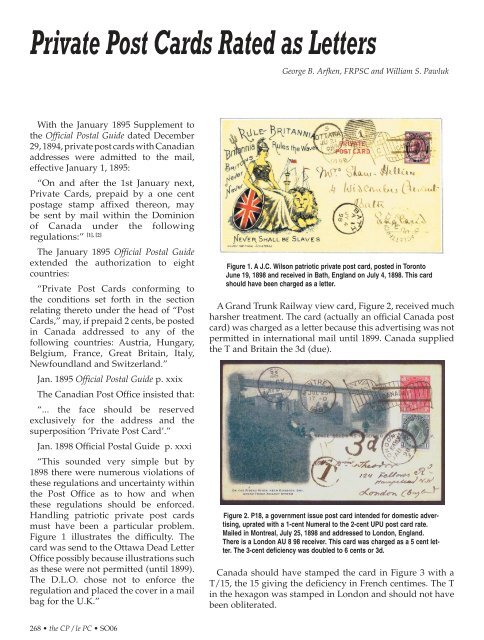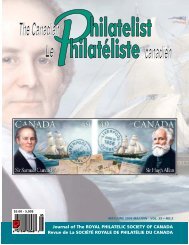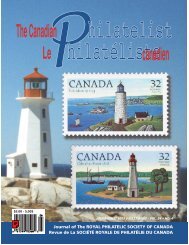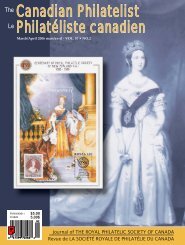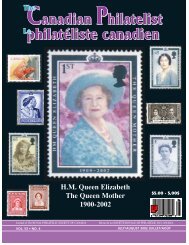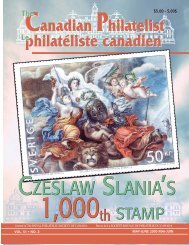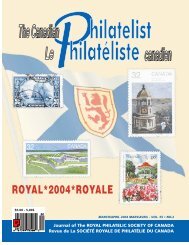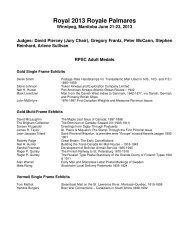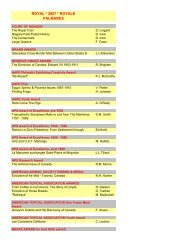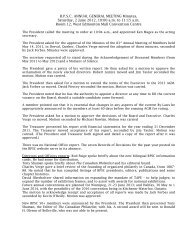Canadian Philatelist Philatéliste canadien - The Royal Philatelic ...
Canadian Philatelist Philatéliste canadien - The Royal Philatelic ...
Canadian Philatelist Philatéliste canadien - The Royal Philatelic ...
You also want an ePaper? Increase the reach of your titles
YUMPU automatically turns print PDFs into web optimized ePapers that Google loves.
Private Post Cards Rated as Letters<br />
George B. Arfken, FRPSC and William S. Pawluk<br />
With the January 1895 Supplement to<br />
the Official Postal Guide dated December<br />
29, 1894, private post cards with <strong>Canadian</strong><br />
addresses were admitted to the mail,<br />
effective January 1, 1895:<br />
“On and after the 1st January next,<br />
Private Cards, prepaid by a one cent<br />
postage stamp affixed thereon, may<br />
be sent by mail within the Dominion<br />
of Canada under the following<br />
[1], [2]<br />
regulations:”<br />
<strong>The</strong> January 1895 Official Postal Guide<br />
extended the authorization to eight<br />
countries:<br />
“Private Post Cards conforming to<br />
the conditions set forth in the section<br />
relating thereto under the head of “Post<br />
Cards,” may, if prepaid 2 cents, be posted<br />
in Canada addressed to any of the<br />
following countries: Austria, Hungary,<br />
Belgium, France, Great Britain, Italy,<br />
Newfoundland and Switzerland.”<br />
Jan. 1895 Official Postal Guide p. xxix<br />
<strong>The</strong> <strong>Canadian</strong> Post Office insisted that:<br />
“... the face should be reserved<br />
exclusively for the address and the<br />
superposition ‘Private Post Card’.”<br />
Jan. 1898 Official Postal Guide p. xxxi<br />
“This sounded very simple but by<br />
1898 there were numerous violations of<br />
these regulations and uncertainty within<br />
the Post Office as to how and when<br />
these regulations should be enforced.<br />
Handling patriotic private post cards<br />
must have been a particular problem.<br />
Figure 1 illustrates the difficulty. <strong>The</strong><br />
card was send to the Ottawa Dead Letter<br />
Office possibly because illustrations such<br />
as these were not permitted (until 1899).<br />
<strong>The</strong> D.L.O. chose not to enforce the<br />
regulation and placed the cover in a mail<br />
bag for the U.K.”<br />
Figure 1. A J.C. Wilson patriotic private post card, posted in Toronto<br />
June 19, 1898 and received in Bath, England on July 4, 1898. This card<br />
should have been charged as a letter.<br />
A Grand Trunk Railway view card, Figure 2, received much<br />
harsher treatment. <strong>The</strong> card (actually an official Canada post<br />
card) was charged as a letter because this advertising was not<br />
permitted in international mail until 1899. Canada supplied<br />
the T and Britain the 3d (due).<br />
Figure 2. P18, a government issue post card intended for domestic advertising,<br />
uprated with a 1-cent Numeral to the 2-cent UPU post card rate.<br />
Mailed in Montreal, July 25, 1898 and addressed to London, England.<br />
<strong>The</strong>re is a London AU 8 98 receiver. This card was charged as a 5 cent letter.<br />
<strong>The</strong> 3-cent deficiency was doubled to 6 cents or 3d.<br />
Canada should have stamped the card in Figure 3 with a<br />
T/15, the 15 giving the deficiency in French centimes. <strong>The</strong> T<br />
in the hexagon was stamped in London and should not have<br />
been obliterated.<br />
268 • the CP / le PC • SO06


